Downtown Sydney Has Incredible Restaurants, Thought-provoking Museums, and a Standout Hotel — Here's Where to Go
Sydney’s once-sleepy office district now buzzes with nightlife, chic hotels, and a lively waterfront.
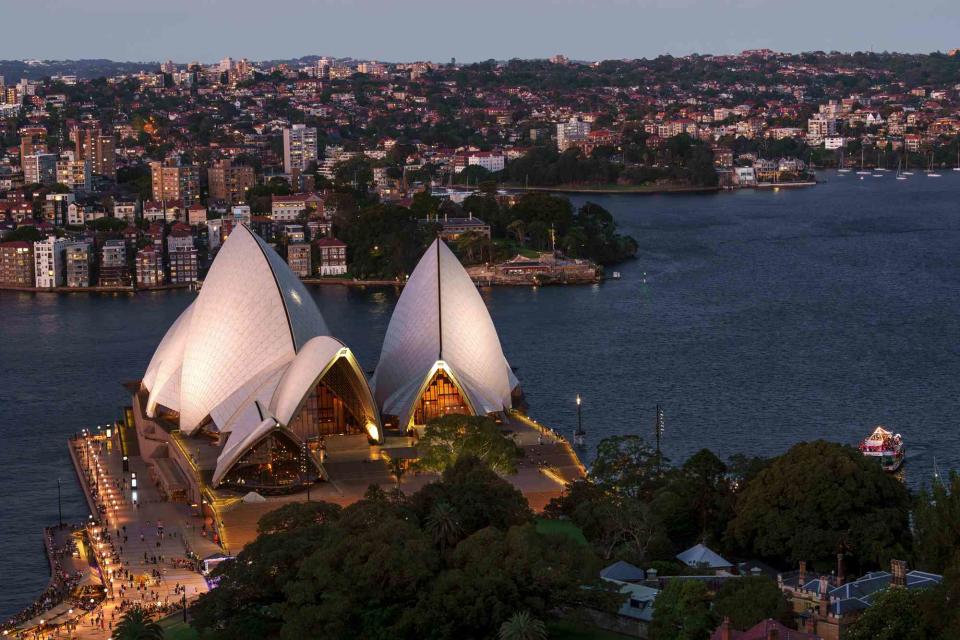
Max Earey/Alamy
The Sydney Opera House.Saturday night at the Sydney Opera House is always a festive occasion, and it was particularly glittery the evening my husband and I took his father to a concert there last fall. The violinist Joshua Bell was performing Mendelssohn with the Academy of St. Martin in the Fields, and concertgoers turned up in their finest, looking sharp against the hall’s bright-pink seats.
During the intermission, we stood out on the western plaza and took in the view of the Central Business District, or CBD, as locals call it — the heart of downtown Sydney, which includes popular waterfront areas like Barangaroo, Circular Quay, and the Rocks. The area’s fortunes have shifted many times over the decades. When the Rocks was redeveloped in the 1960s and 70s, hundreds were displaced from public housing. My husband (who is from Sydney) recalled that in the 90s and 2000s, no one really went there other than to work. Then the pandemic emptied the place out.
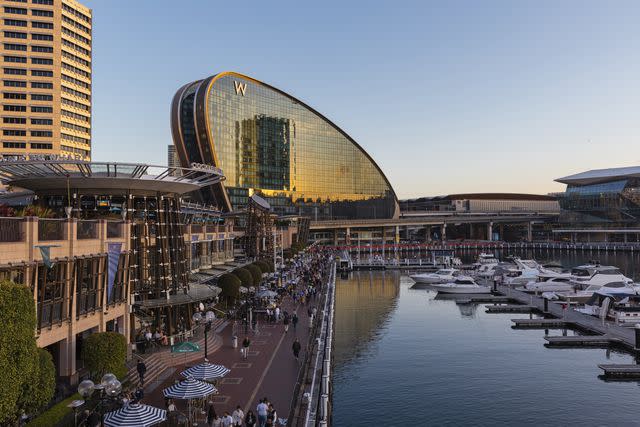
Ai Yoshi/Getty Images
The W Sydney, on Darling Harbour.Now the CBD is changing again. With new tram lines, a revitalized harbor, an expanded museum, and the opening of high-end hotels and restaurants, the district has become one of the city’s most vibrant areas — and a model for mixed-use development where economic renewal is balanced with cultural inclusivity.
"That the CBD is now a place to see and be seen is a marked change from several years ago, when it was largely a ghost town on Saturday nights. Buzz-seeking diners who would otherwise go out in the suburbs of Bronte or Surry Hills are thronging to downtown spots."
One of the best examples is the year-old Capella Sydney, the brand’s first property in Australia and the first luxury hotel to open downtown in about two decades. Occupying a meticulously restored government building from the early 1900s, the Capella has an ornate sandstone façade and a wrought-iron staircase, 192 sumptuous guest rooms, and a marble-lined pool.
Related: Our Readers' Favorite Hotels in Australia and New Zealand of 2024
The hotel has contributed to the CBD’s revival by breathing new life into historic structures, said David Tsang, CEO of Pontiac Land, Capella’s parent company. “These were imposing buildings that most people had never been inside of,” he told me. “Hospitality makes them more porous and vibrant.”
That vibrancy was on full display during our stay. There was an international opulence to the design, with high-tech features and contemporary art from around the world. In the morning, the hotel’s restaurant is a hot spot for power breakfasts; evenings, it’s filled with couples dressed for date night. Yet the old bones of the building, as well as numerous works by Australian and Aboriginal artists, imbue the hotel with a sense of place. A nice touch is the daily tea service, where guests can hear the stories of local Aboriginal figures.
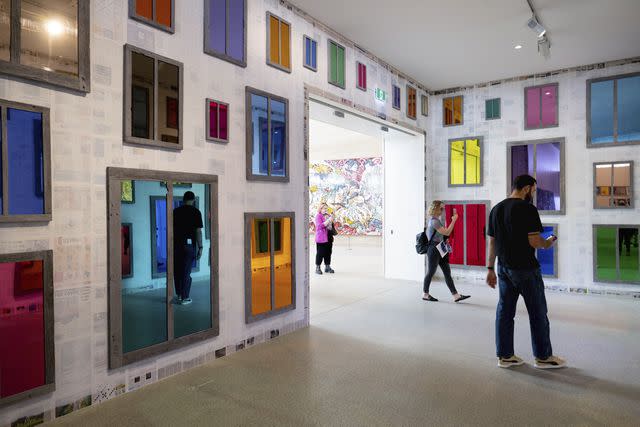
An installation by Ugo Rondinone at the Art Gallery of New South Wales.
Celebrating cultural heritage and diversity is an integral part of the CBD’s reinvigoration. I’ve been visiting Sydney regularly for decades, but have never seen such a widespread public reckoning with the city’s Indigenous past. Nearly everywhere these days there is an acknowledgment that the CBD sits on land of the coastal Gadigal people. Aboriginal culture is showcased at galleries, in public parks, on television, and on menus.
Before the concert, we had dinner at Midden, the flagship restaurant at the opera house created by Mark Olive, who is one of Australia’s most celebrated Aboriginal chefs. The menu, which showcases native ingredients, introduced me to flavors I’d never tasted, like bush tomato, which was both blended into a gazpacho and braised with a wallaby shank.
"I’ve been visiting Sydney regularly for decades, but have never seen such a widespread public reckoning with the city’s Indigenous past."
Midden was a hard table to book, as are other restaurants in the area. That the CBD is now a place to see and be seen is a marked change from several years ago, when it was largely a ghost town on Saturday nights. Buzz-seeking diners who would otherwise go out in the suburbs of Bronte or Surry Hills are thronging to downtown spots like Ragazzi, a tiny trattoria known for its handmade pasta and Australian wine made from Italian varietals; Bar Totti’s, always packed with revelers grazing antipasti; Clam Bar, with its throwback menu of oysters Rockefeller and three kinds of caviar; and Le Foote, a new brasserie that feels like it’s been there for a century and serves wood-fired dishes like roasted barramundi and charred cabbage.
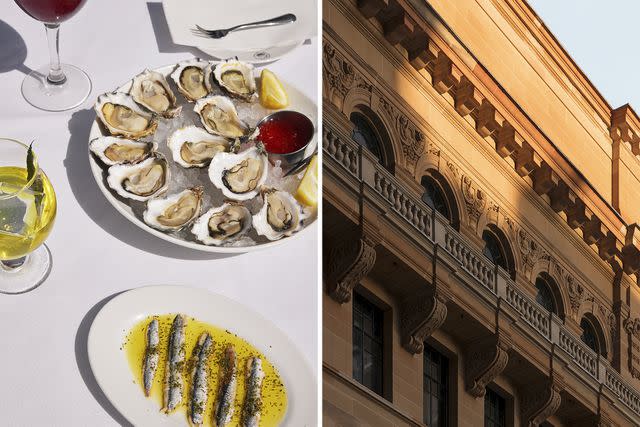
From left: Andrea Veltom/Courtesy of Le Foote; Timothy Kaye/Courtesy of Capella Sydney
From left: Oysters and anchovies at Le Foote; the Capella Sydney hotel.I asked Justin Hemmes, who owns Bar Totti’s and more than 30 other establishments in the neighborhood, what was fueling the revival. He pointed to the new L2 and L3 lines of Sydney’s light-rail network, which link the CBD to the rest of the city, and to the rise in outdoor dining during the pandemic. “They’ve created a bustling and lively atmosphere with foot-traffic numbers unlike anything I’ve seen in 20 years,” he said.
This was certainly true on a weekend night at Jimmy’s Falafel, a spot on George Street with a cool 70s casbah feel and a live DJ. Tables were turning fast, with diners of all ages digging in to superb Middle Eastern small plates. I was struck by how relaxed and happy everyone seemed. Sydney is a gorgeous city, with 100 beaches and a come-as-you-are attitude — famously on display in neighborhoods like Bondi Beach. It was refreshing to see an area previously dominated by office culture begin to develop an Aussie flavor all its own: laid-back, but also polished and sophisticated.
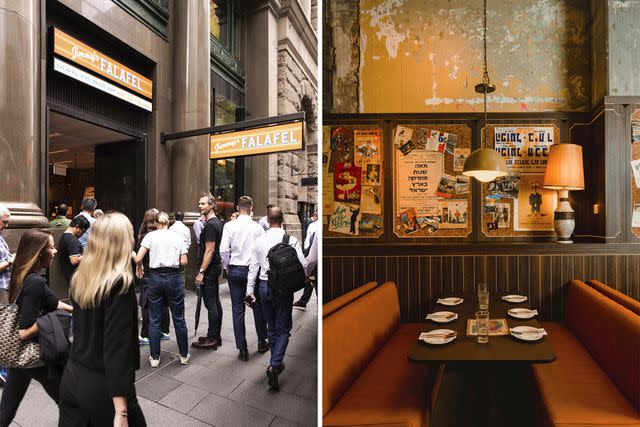
From left: Courtesy of Jimmy's Falafel; Jiwon Kim/Courtesy of Jimmy's Falafel
From left: The casbah-chic interiors at Jimmyâs Falafel; the after-work crowd outside the restaurant.And walkable. Unlike much of Sydney, which is spread out and requires a car, the CBD is knitted together with new plazas and green spaces. You can spend a very pleasant afternoon exploring the waterfront on foot, starting at Darling Harbour, which is anchored by the new, wave-shaped W Sydney, and heading north to Barangaroo, perhaps stopping for a veal Milanese at a’Mare, inside the Crown Sydney hotel.
Continuing east takes you past Circular Quay and the opera house, until you reach the Botanic Gardens and the Art Gallery of New South Wales, the city’s leading art museum. In 2022 the Art Gallery opened a modern, multilevel glass structure designed by the Tokyo-based firm SANAA, along with an art park by the landscape architect Kathryn Gustafson. The museum announced in April that the addition would be named Naala Badu, which means “seeing waters” in the language of the Dharug people, who are native to what is now Sydney.
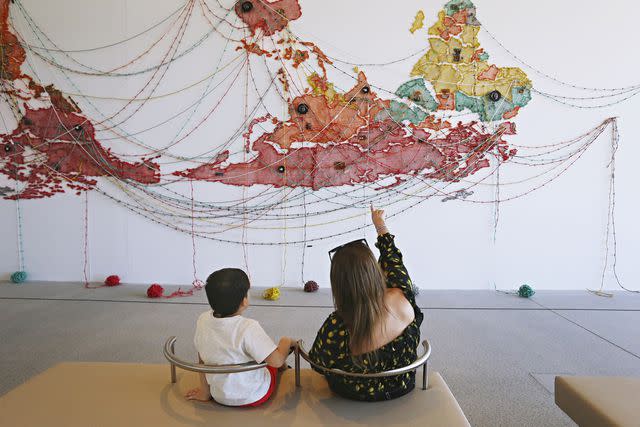
Lisa Maree Williams/Getty Images
Visitors at Naala Badu, part of the Art Gallery of New South Wales.It’s the most significant addition to the artistic life of Sydney in many years, nearly doubling the museum’s exhibition space. Central to the mission is the foregrounding of works by Aboriginal and women artists. The original gallery, which occupies a 19th-century sandstone building, confined its Aboriginal pieces to the lowest level, and the bulk of its collection was mostly composed of works by white men. Now, most of the new commissions are by women artists, and its evolving Aboriginal collection is woven through multiple exhibits.
On my visit, I saw works by the contemporary Aboriginal artist Tony Albert next to an Ed Ruscha canvas — a bracing redefinition of the modern-art canon. I was introduced to many artists whose work I didn’t know and made me see the ones I did in a different light. It was a revelation. “When I grew up, we thought we were a young country — Captain Cook discovered us,” Dr. Michael Brand, the museum’s director, told me. “In fact, we have this other history.”
A version of this story first appeared in the August 2024 issue of Travel + Leisure under the headline "Happy Hour."
For more Travel & Leisure news, make sure to sign up for our newsletter!
Read the original article on Travel & Leisure.


